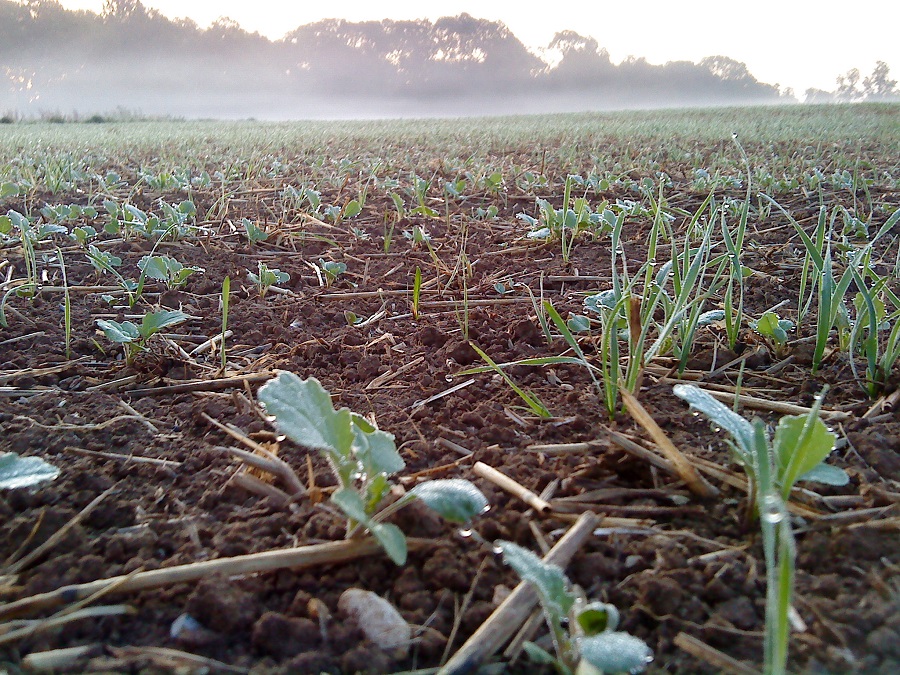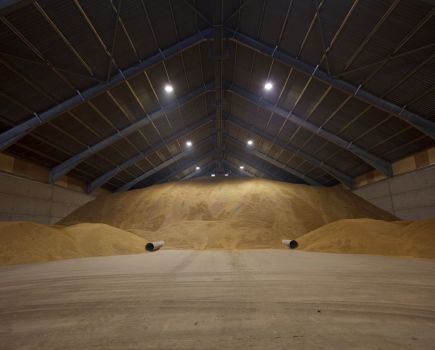Avoiding the main migration period for cabbage stem flea beetle by drilling either very early or late has become the new norm to give oilseed rape crops the best chance of establishing. CPM looks at the implications on disease control.
Anything that injures the leaf makes the plant more susceptible to infection.
By Lucy de la Pasture
Many growers have been taking advantage of the early clearance this harvest and oilseed rape has been going in the ground since late July. Although disease may not be the first priority, time of drilling has an influence on the diseases that affect OSR, says ADAS crop pathologist Dr Julie Smith.
For grower’s planting early, light leaf spot (LLS) is the foliar disease that crops are most at risk from, she explains. “LLS is initiated by ascospores which are released as soon as the previous OSR crop is harvested. If early sown, then the crop is exposed to ascospores over a longer period of time and we tend to see higher levels of disease in earlier sown crops.”
“LLS lesions can form as early as two weeks after infection when average temperatures are 15⁰C although we often don’t see infection in the field until Nov. Infection can then spread to other plants through rain splash, in a similar way to septoria in wheat.”
The tricky thing about LLS is that early infection isn’t always at a level that’s noticeable in the field because it is so sporadic. The fungus infects leaves and produces conidiospores, which look like salt-like grains on the leaf surface. New leaves on the same plant and/or adjacent plants are infected by rain splash, so early infection is patchy and easily missed.
“Just how much the disease spreads from these initial foci of infection depends on the amount of rainfall and temperature. When LLS symptoms are detected in the field, it might be the second or third generation that’s present.”
Because the disease is polycyclic, infection can be present in the crop at all stages in its lifecycle at any one time, which can make control a little tricky. Fungicide sprays applied for phoma control will also cover the susceptible stages of LLS present at the time of spraying, she explains, but depending on the timing of the spray it may or may not offer enough protection against LLS
The better news for early sowers is that their OSR will be at a lower risk of heavy yield loss from phoma stem canker, says Julie.
“Phoma ascospores land on the leaf and the fungus has to grow through the leaf and into the petiole to reach the stem. An early drilled crop is stronger and has bigger leaves which means the phoma fungus has further to grow to get to the stem of the plant. In these more forward crops, older infected leaves often fall off the plant before the fungus has a chance to get as far as the stem.”
Unlike LLS, phoma is a monocyclic disease and it’s much easier to forecast when the disease will strike. The epidemic begins with an infected stubble which releases ascospores into the air, a process which is triggered when there are more than 20 days during Aug/early Sept when there has been a period of rain, she explains.
“Once the phoma ascospores have landed on leaves and germinated, leaf symptoms become visible after approximately 120 accumulated day degrees. So if it’s an extremely warm autumn with mean temperatures of 20⁰C, symptoms would be apparent after just 5-6 days but longer as conditions cool down, i.e. 30 days at 4⁰C.
“The time to apply a fungicide for phoma control is when 10-20% of the crop has symptoms and there are models that can predict when this is likely to occur. There are also several varieties with good levels of resistance to phoma and LLS which give added flexibility to spray timings by delaying the start of the epidemic.”
The relationship between CSFB infestation and foliar disease hasn’t been studied but Julie believes it would make sense that a plant under stress would be more susceptible to disease.
“Ascospores need nutrients to germinate so anything that injures the leaf, such as wind or pest damage, allows direct access to the nutrient source and makes the plant more susceptible to infection.”
Eye in the sky
A new phone app has been developed that uses a drone to gather crop images for phoma detection. ‘Skippy Scout’ uses high resolution leaf images to spot the signs of diseases which could reduce losses this season, says Jack Wrangham, founder of the app’s developer Drone Ag.
“Based on annual survey data presented by Crop Monitor, it’s estimated that phoma results in losses of about £100 million each season despite fungicide treatment. Using Skippy can help identify phoma infection earlier,” he says.
AHDB offers a phoma forecast which, in conjunction with regular crop walking, can improve the chances of catching the disease early. Skippy Scout uses field maps to automate drone flight. By uploading field maps, farmers can choose points in fields for the drone to fly to and take images. The high-resolution images have sufficient detail to spot the very early signs of phoma.
Robert Ord is an agronomist with MSP and has been using Skippy Scout to monitor crops. “I’m able to cover more crops in more detail by using a combination of conventional methods and Skippy. The drone can spot problems quickly which enables me to make best use of my time. With Skippy I can also save data from points in a field to analyse crop establishment and development at different stages in the growing season,” he says.
Phoma is typically treated with one to two sprays, depending on variety and the season. Using data collected by a drone can help to establish the optimum timing, explains Robert. “It’s about collating data from all available sources and being able to continually monitor the crop for small changes. The most time efficient way to do this is with a drone.
“It’s roughly five times faster to walk a crop using a drone in comparison to traditional methods. If we are going to improve OSR yields, we should be making best use of all the resources available to us,” he adds.




